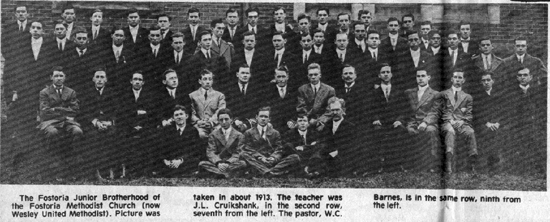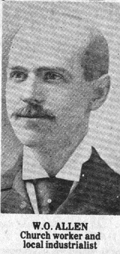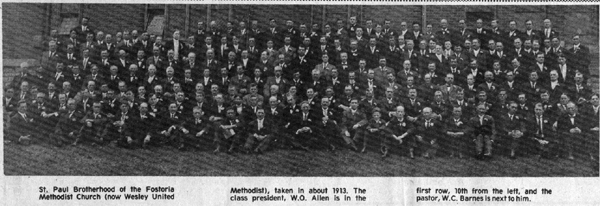December 11, 1980



Picture #1 – The Fostoria Junior Brotherhood of the Fostoria Methodist Church (now Wesley United Methodist). Picture was taken in about 1913. The teacher was J.L. Cruikshank, in the second row, seventh from the left. The pastor, W.C. Barnes, is in the same row, ninth from the left.
Picture #2 – W.O. Allen – Church worker and local industrialist.
Methodists should be glad to see today’s column, and the nostalgic photos from the early 1900’s…both of which provide evidence of the dynamic church that existed here years ago.
Before getting to the story proper, I must tell you how it came about. Two or more years ago, while visiting with Mrs. Taylor Brumbaugh and daughter Tiffany, former Fostorians, while looking through old family photos and other memorabilia, we came across an old newspaper which published stories about the Methodist Ohio Conference in Urbana in September 1913.
For that occasion, the Urbana Daily Citizen had printed an eight-page section about the Methodist’s Conference. At that time, I did not read it thoroughly. But my eyes and mind did observe the photos and register them indelibly.
I forgot about the paper until recently when Martha Hall shoed me photos owned by D.E. Gear, one of which was of the old Methodist Church on Summit Street and was used with their column recently. Another is used with today’s story. As soon as I saw them, I remembered they were published in the Urbana newspaper in 1913.
Neither the photos or the old paper separately would have been of any value in developing this story, but together they did.
8-PAGE PAPER ABOUT METHODISTS
The old newspaper devoted pages 1 and 2 to the Fostoria Methodist Church, with the same photos used in today’s article, plus many others, mostly men, who were the stalwarts in the local church then and for many years afterward.
The banner headline on page 1 was “The Methodist Church of Fostoria – The Men’s Church”. And the headline was emphasized by an editorial on page 2, written by Rev. Carl D. Yoder, editor of The Conference Edition which said:
“It is a pleasure to present to the Methodists of the Conference the fine article prepared by the good Methodists of Fostoria in honor of their church. It is a fine Christian organization. It is unfortunate that it should be unique in being “A Men’s Church”. If there were more of them it would be well”.
“The men of Fostoria have taken hold of the work of the church with enthusiasm and zeal. They have given to it some of the same energy that men usually give to business or to politics. The results show what men can do if they are determined in Christian work as to secular affairs”.
“Perhaps one reason is that the pastor is a manly man, a good business man, as well as a good preacher and a man who draws men to him”.
“Fostoria is a splendid progressive city. It fairly pulses with life and business activity and it is none the less prosperous because of a goodly part of the brains of the men of the community is exercised in behalf of something besides self and pelf”.
“The First Methodist Church of Fostoria is an honor to the West Ohio Conference and the Daily is glad to give it this recognition”.
DR. W.C. BARNES WAS PASTOR
The Fostoria Methodist Church had Dr. W.C. Barnes as pastor, and he had already been returned to the church for request for four years.
Under Barnes leadership, the church was making rapid strides in many ways.
The Sunday School had an enrollment of nearly 1,000 and the average attendance was over 600.
After the Stough Evangelistic campaign in 1912, the church attendance doubled according to one report in the paper.
The Fostoria Junior Brotherhood, a Sunday School class of young unmarried men, with J.L. Cruikshank as teacher was active in the church.
The St. Paul Brotherhood, for older men, had as its president W.O. Allen, an enthusiastic Christian layman in the local church and in the community, as well as the West Ohio Conference. Allen, personally financed the salary for Rev. John George, who served as the pastor’s assistant, and worked with the Brotherhood on various projects, which included the building of a mission church in India.
The men’s brotherhood class kept its activities in harmony with the church and had three purposes for existence: (1) religious and spiritual results in the church (2) promotion of missions (3) local charities.
WOMEN’S ORGANIZATIONS ACTIVE TOO
Women’s activities, however, were not neglected even though the men had a strong influence. There were the women’s missionary society groups. The Ladies Aid Society was headed by Mrs. Dr. A.J. Reycraft. The Women’s Home Missionary Society, with 74 members, was headed by Mrs. Dr. G.W. Emery. The Women’s Foreign Missionary Society, with 88 members was headed by Mrs. C.W. Barnes. The Young Ladies Foreign Missionary Society, with 80 members was headed by Mrs. Mary Caples Brown. The Young Ladies Home Missionary Society, with 20 members was headed by Mrs. Dr. A.J. Reycraft.
There was also a group of approximately 30 young ladies, called the Cheer-Up Band, who called on the sick and shut-ins throughout the community on Sunday afternoons and evenings, whether members of the church or not.